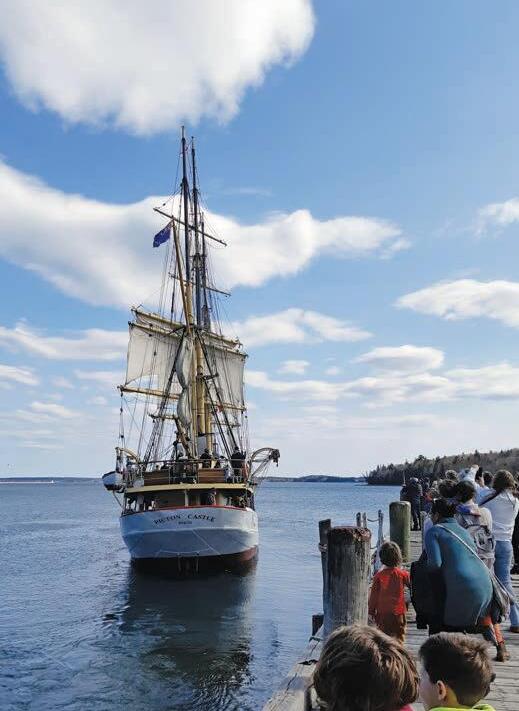
17 minute read
Around Again
After three years of pandemic-related delays and an unscheduled five-month stint on a broken railway, PICTON CASTLE is once again on her way around the world
On May 10, Picton Castle sailed from her home port of Lunenburg, Nova Scotia on a long-delayed circumnavigation. Less than 200 nm into the voyage, she had to return, due to a medical issue. But after waiting out a few days of bad weather, she finally broke free, and at press time had arrived at the Caribbean island of Anguilla.
Advertisement
We spoke to CEO Maggie Ostler in June, a week after the (second) departure, as she took a break from sweeping up the confetti on the Lunenburg docks.
Marlinspike: First of all — congratulations!
Maggie Ostler: Thank you. To finally have the ship underway again is pretty exciting! All the crew especially are so happy. They really, really stuck with it. They were persistent and tenacious and just hung in there until we could finally get to sea. And they’re a great group. We’re really pleased with the crew that we have on this voyage.
MS: How many of the crew were able to wait out the three years of delays? You must have suffered some turnover, as people’s windows opened and closed for them to be able to participate.
MO: Yes, there was some turnover, but the vast majority of them stuck through all of the delays. The voyage was originally supposed to start in the spring of 2020, so there are folks who have been signed up since 2019 for this voyage! Others had signed on since 2020, and even in the weeks and months leading up to the start of the voyage this spring. We sailed with 40 people on board. And we’re full at 50.
But I should tell you about the day the ship left Lunenburg, because that was incredible. The ship sailed on a Wednesday, the ship was going to leave the wharf at four o ’clock in the afternoon, and we only made the final call about timing on late Tuesday afternoon. So we had less than 24 hours notice.
We’d decided we didn’t want to do a big media push, but there had been such a buzz about the ship leaving, that we did a social media campaign locally, through our local community bulletin boards and groups and things like that, to let the people of Lunenburg and the surrounding area know that the ship would be sailing and that they were welcome to come down and see her off.
And by four o’clock on Wednesday afternoon, we had probably close to 300 people on the waterfront — maybe more on some of the other wharves that I couldn’t see. We’ ve often had a crowd that big for a homecoming, when the ship comes back from a voyage, but we have never had a crowd that big to send her off. It was really special. I get a little emotional talking about it, actually.
People just wanted to come out and, and show their support for the ship, after such a long time here in Lunenburg, especially after this past winter where we had a number of the crew here and they had the opportunity to get to know folks around town. Many of those people came out to see the ship off and say goodbye to the crew: the staff at the local grocery store, the servers at the pub, and everybody in between.
MS: It was noted, back when Ocean Classroom folded in 2014, that it’s hard for a community and a boat to bond when that boat’s gone for months or years at a stretch. But with Picton Castle home for such an unprecedented long time, you got the opportunity to build those bonds. Just getting used to seeing the boat there, and having the crew around…
MO: The crew bring a vibrancy and an energy to the waterfront. Lunenburg feels it during the summertime. During the season, when the Bluenose II crew are around, you ’re seeing active, vibrant, young people on the waterfront, engaged in the business of the waterfront. Having Picton Castle and her crew here for an extended period of time gave that feeling as well. Having vessel crews, particularly youthful vessel crews, on the waterfront, breathes life into Lunenburg and into the… I don’t want to say the heritage, because that makes it sound like it’s in the past… but the culture of a working waterfront.
MS: After all the pandemic-related delays you had to wade through, the barque was then stuck on a railway for quite some time, no fault of yours. How much did that hold you up?
MO: I think we got hauled out on a Wednesday and we were supposed to be launched the following Tuesday. It’ s one of those marine railways where the cradle is divided in half. It’s quite long. They can launch the whole thing, or they can launch just the bottom half.
So, while Picton Castle was up on the dry dock, they went to launch the bottom half to pick up another ship for a short repair. In the process of launching the bottom half of that cradle, the winch that hauls the cradles up and down broke. That left Picton Castle stuck on the upper half of cradle.
We thought we were going to be there for a week. We ended up being there for five months.
MS: Ouch. Good thing she’s not a wooden boat…
MO: [Laughs] Yeah! Anyway, the hull was in great shape. Within that first week, we had done a couple little steel repairs and a new coat of bottom paint, and the ship was ready to be relaunched. Sitting there for another five months didn’t do any particular damage to the hull, but it was hard on the decks and the rigging.
MS: Did you realize that you would be stuck for a while when the winch broke, or was it like “We think we’ll have it fixed next week”… every week for five months?
MO: We originally were told that it was going to be six to eight weeks. And then it just sort of kept extending from there. Had we known, we would have approached things differently. But it’ s one of those hindsight-is-2020 things.
MS: I guess the good news was: the boat had plenty of time get ready, and the crew know each other better, and have been working together longer, than is normally the case at the outset of a new voyage.
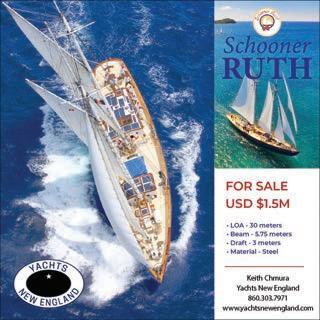
MO: Absolutely! That’s one of the things that I think is going to make this voyage unique, from a crew perspective.
First, there’s the long period of anticipation, all the stops and starts and on-again, off-again that we’ve had… that created this sense of such joy [laughs] at just being able to get underway. People have been looking forward to this for a very, very long time.
When we had the drydock delay, we gave the trainee crew the option either to stay with us here in Nova Scotia, sort of wait it out, or leave for a little while and come back. And many of them stayed. And with the extra time that they spent in Lunenburg, they’re more skilled than a lot of the crew around our previous voyages. We always have a long pre-voyage period here in Lunenburg. That gives the crew a chance to get to know each other, and we have time for training and safety drills and all of that stuff. But these guys got into some of the seamanship stuff that we normally wouldn’t do until the voyage began. So they’re already pretty good at some of the skills that normally people wouldn’t learn until we put to sea.
MS: Picton Castle is getting on in years, for a circumnavigator. What work needed to be done to her for this voyage?
MO: The work that we did in drydock was pretty routine. Almost every time we haul the ship out, we inspect the hull, we gauge the hull thickness. We were pretty pleased with what we found, and anywhere where it was less thick than we would like, we did some sort of repair or addition. But that would have all fit into the week that we were scheduled to be out.
I will say that, having the ship sit in Lunenburg without a crew for the duration of the pandemic, there was a lot of work needed to bring her back into service. A lot of that was inspection related. So before we sent the crew up into the rigging for the first time, we did a really thorough rigging inspection, just to make sure that things were in good shape. And then there’s all the coatings and paints and varnish [laughs] and we definitely needed to get some tar in the rig.
Even just now, I had a report that the crew have been working on varnishing the pin rails and the fly rail around the front of the bridge. We needed to take them back down to bare wood and get some fresh varnish on there. A lot of painting and varnishing and tarring and greasing and oiling was required, to get her back into shape.
MS: Last time I checked, they were pretty close to the West Indies. Hopefully they’re getting some good varnishing weather.
MO: They’re actually in Anguilla right now! They arrived Friday [June 2]. It wasn’t part of the itinerary, but we threw in a surprise Caribbean stop for the crew just to give them some tropical blue-water swimming and toes-in-the- sand before we head for the Panama Canal. Our plan originally was to go straight to Panama and out into the Pacific as soon as we could. But the tropics called [laughs] so we’ve thrown in a little surprise stop for the crew.
MS: Is this route different than the one Dan would have chosen had the boat left earlier?
MO: In terms of the route, it’s very similar. We’ll be hitting all the same island groups, but we will be visiting fewer islands in each group or country. In terms of the distance that we’re covering, the number of nautical miles is about the same, but port stays are a bit shorter. We had planned to go to a number of different islands in French Polynesia, but it looks like we ’re only going to get to a few of them now.
MS: Getting back to the barque herself — how long can she keep going?
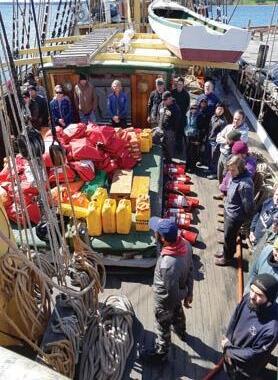
The crew conduct safety drills at the dock in Lunenburg before departure
MO: [Laughs] That’s a good question! I’m not sure that I’m the right one to answer that question. I feel like Dan would have an answer for that.
MS: Then let me merge those two questions. Dan is getting on in years, for a circumnavigator. What work needed to be done on Dan to get him ready for the voyage?
MO: [Laughs] He is saying that this will be his last long voyage. I think that he will keep going to sea for shorter periods, but I think that this will be his last long one.
MS: And he has family with him on this voyage?
MO: His 10-year-old son is with him, and his wife will be joining them shortly. She’s still in Lunenburg, tying up loose ends.
MS: When Dan says “this is going to be my last long voyage,” he’s kind of leaving the door open there, isn’t he?
MO: I think so, yeah. I mean, for somebody who has spent the majority of his life at sea, I feel like doing anything other than that would be a big shift for him. But at the same time, I think he also feels like he has other things he wants to focus on. Things like the Bosun School, and some other projects as well.
MS: I feel like we were at this same point before COVID, when Dan was talking about how both he and the Picton Castle were going to focus on shorter trips in the future.
MO: Yeah, and we have been talking about that for a while. When COVID came, we gave serious thought to what was the right thing for Picton Castle to do. There were so many unknowns about the logistics of international travel, and what would be required in all of the different countries, that we made the decision to go back to what we know best, which is a world voyage. Those are waters we know, that we’re familiar with, the winds and the currents and all that other stuff.
We know what navigating into the ports is going to be. We know what the holding in the anchorage is going to be like. We have contacts in those ports who have become friends of the ship. With so many unknowns, we made the decision to — although a world voyage is never easy, it’s not a small undertaking — to go with what we’re most familiar with.
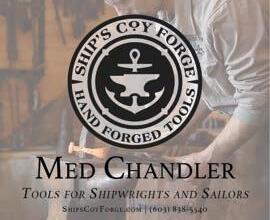
MS: Now that the voyage is well and truly underway, what opportunities are there for people to join? Is there availability on all of the remaining legs?
MO: We are currently full and about to start a waitlist for the second leg, which starts in August and goes until November. That’s from Tahiti to Bali. We do have availability on the third and fourth legs of the voyage. The third leg is Bali to Cape Town, and the fourth leg is Cape Town home to Lunenburg.
MS: And if people are interested in that, what’s the best way to contact you — through the website or directly?
MO: Through the website, although our website is out of date at the moment, and we’re having technical issues where we can’t update it. So we’re hurrying our way through getting a new website launched, and that should be ready to go soon.
MS: And it will have a tracker, I hope?
MO: Yes, absolutely. We have a tracker unit on board that pings automatically every eight hours and updates the ship’s position.
MS: What do you do in the office while the ship is out sailing around the world?
MO: People often say, ‘Oh, the ship is gone. You must have nothing to do!’ Not the case at all.
We’re working a number of ports ahead of the ship and making all the logistical arrangements, making sure that the ship has a dock or an anchorage to go, that fuel is arranged, provisioning is arranged, all of that stuff. There’s the Panama Canal and all of that. We’re also working with crew who are going to be joining the ship. Right now we’re working on getting the folks who are going to fly to Tahiti in August, ready to sign aboard.
And we’re working on making sure that there are communications coming from the ship that we can share with folks. We’ve been keeping our captain’s log up to date on our website. Every day the ship is underway, we have a little update — we call them Day’s Runs — that we’ ve been posting on social media and on our website with information about the ship’s location, the weather, how many nautical miles they’ve made in the past 24 hours, all of that stuff.
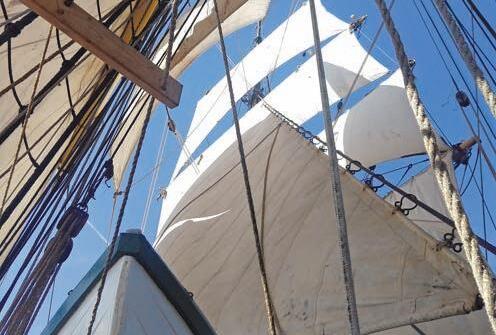
PICTON CASTLE sets some of her 12,000 square feet of sail on the first leg of her voyage
MS: I’ve been following them. When we started the magazine, almost 10 years ago now, Picton Castle was in the midst of a world voyage, and one of the regular features that we hoped to have was Dan’s journal. People really enjoyed that. Of course, communication is so much better now. I assume you can get up-to-date photos and things like that — high-res photos — whereas 10 years ago we used the same damn photos over and over [laughs].
MO: We still struggle a bit in the hi-res photography department. But yeah, communications at sea have come so far. When I started working in the office, we had a system where we paid per character — for every letter, every period, every comma, every space. Now we can be quite verbose, in text. But sending photographs, that’s still a challenge.
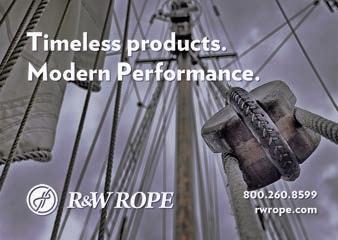
MS: Anguilla is not a big island. I imagine that a barque with 40 sailors showing up would blow the doors off their customs office. How do you prepare for an unscheduled stop at a place like that? What does your office need to do to make that happen?
MO: We are fortunate to have friends in a lot of the places that we visit. We actually have a former crew member who’s from Canada, but moved to Anguilla shortly after sailing with us. She and her husband have been super helpful with local arrangements and that kind of stuff, along with a ship’s agent whom we work with at Anguilla. Despite the size of the island, they do get a fair amount of visiting sailing vessels.
One of the nice things about Anguilla is that we get to anchor, so we don’t need to worry about making arrangements to go alongside. And we’ re sending all the paperwork in advance, the crew lists and ship manifests and all that. We’ve had two crew meet the ship in Anguilla as well, so that took a bit of coordination.
The opportunity to support the crew while they do this amazing thing is really rewarding. I’m kind of a nerd, I like the logistical stuff. I always like to know the behind-the-scenes of how things happen.
MS: Do you ever wish you were on the barque, and someone else was doing the office work?
MO: Occasionally! [Laughs] I won’t lie about that. But I’ve had my voyage. I did a world voyage as a trainee, and sailed on a part of another world voyage as professional crew. So I know how amazing it is, and I want to give other people the opportunity to experience that for themselves.
MS: Before you go, what can you tell us about the last delay — the medical issue on board that forced the barque back to Nova Scotia?
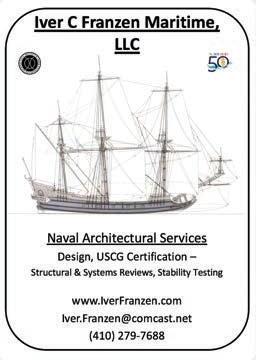
MO: Picton Castle left Nova Scotia and was not quite 200 nautical miles off the coast when a medical situation developed on board, and pretty quickly, Captain Moreland made the decision to turn around and come back. We got the crew member ashore, to a hospital, and they received medical diagnosis and care. The ship came to anchor; she didn’t come all the way back into Lunenburg. It was quicker, that way, to get this crewmember to a hospital.
The ship came to anchor on a Sunday afternoon, and we knew that there was some unpleasant weather coming through on Tuesday. So Captain Moreland made the decision to stay at anchor through Monday and Tuesday and get under way again on Wednesday.
Meanwhile, the crewmember who needed medical care has just flown down to the Caribbean and rejoined the ship!
Be sure to check out the barque’s new website and follow her as she transits the Canal and heads through the Pacific!


